Shooting Stars, the Waxing X-Moon among Evening Trees, Spotty Saturn Shines Nightly and Mars Attacks Jupiter!
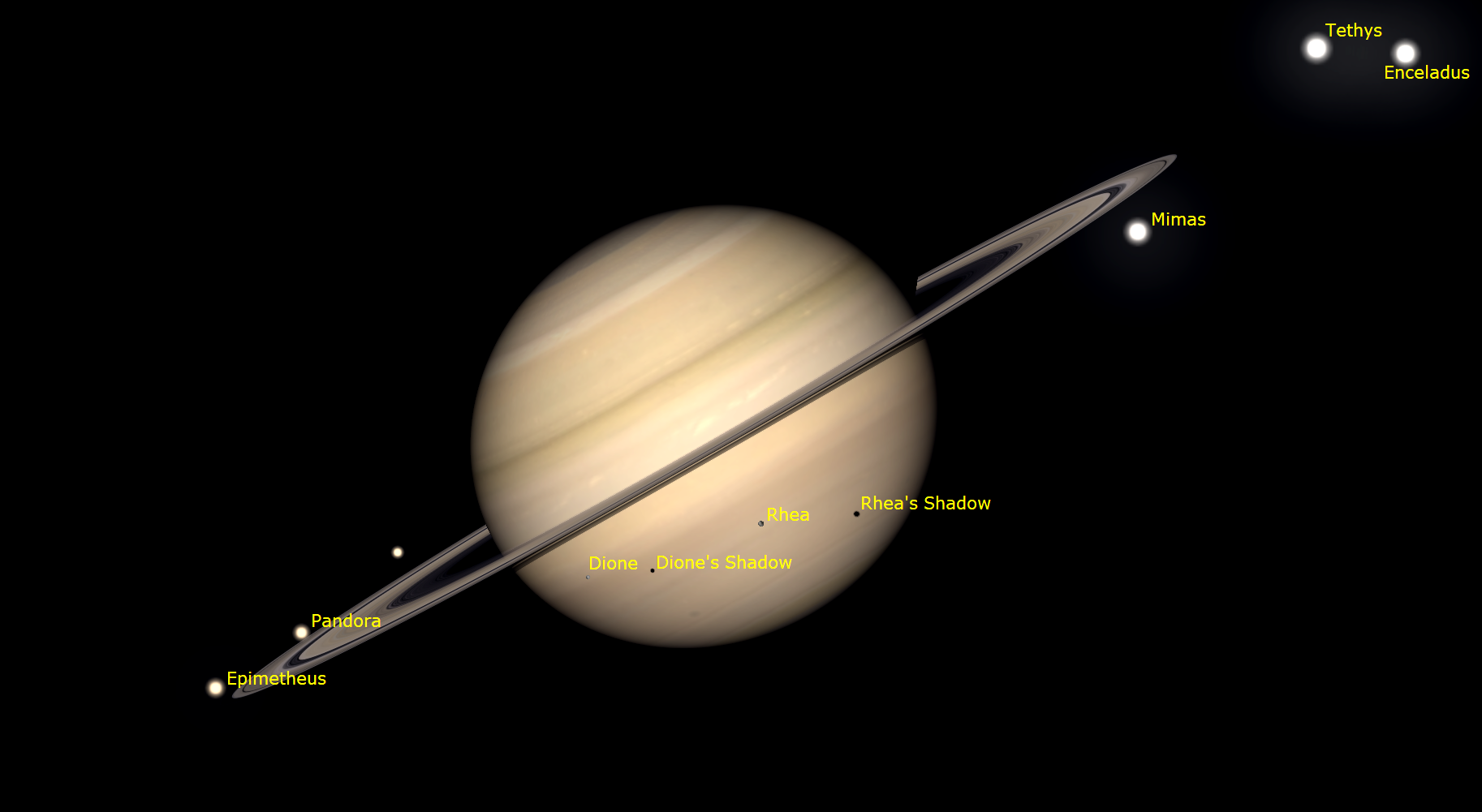
Hello, mid-August Stargazers!
Here are your Astronomy Skylights for the week of August 11th, 2024 by Chris Vaughan. Feel free to pass this along to your friends and send me your comments, questions, and suggested topics. You can also follow me on Twitter as @astrogeoguy! Unless otherwise noted, all times are expressed in Eastern Time. To subscribe to these emails please click this MailChimp link.
If you’d like me to bring my Digital Starlab portable inflatable planetarium to your school or other daytime or evening event in Simcoe, Grey, and Bruce Counties, or deliver a virtual session anywhere, contact me through AstroGeo.ca, and we’ll tour the Universe, or the Earth’s interior, together! My book with John A. Read entitled 110 Things to See With a Telescope is a guide to viewing the deep sky objects in the Messier List – for both beginners and seasoned astronomers. DM me to order a signed copy!
The waxing moon will brighten and shine during the evening this week, but it will hang rather low in the sky for Northern observers. The Perseids meteor shower will peak tonight (Sunday) while the moon sports an X and L-O-V-E letters. Venus appears after sunset, Saturn shines by midnight, and Mars will brush past brilliant Jupiter in the morning. Read on for your Skylights!
Perseids Meteor Shower
Last week here I shared some background material and viewing tips for the annual Perseids meteor shower since it would be ramping up to its peak after midnight tonight (Sunday). The shower will be visible from everywhere on Earth, but it will be better for those of us in the Northern Hemisphere because its radiant is 57° north of the celestial equator.
The Perseids shower can deliver 60 to 100 meteors per hour at its peak – many of them as bright, sputtering fireballs! Some will leave “smoke trails” that take a few minutes to dissipate. Even if there are fewer than hoped for, the ones you do see will be worth the effort!

Moonlight (and city lighting) obscures the fainter meteors. With a 44%-illuminated, waxing crescent moon setting in late evening, the time for seeing the most Perseids meteors will be between 11 pm on Sunday and dawn on Monday morning, while the shower’s radiant in Perseus is high in the northeastern sky. Be sure to look up starting after sunset, though. That’s when extra-long meteors grazing Earth’s upper atmosphere can appear blazing across the twilit sky.
You can’t see meteors through clouds. If your sky will be cloudy on Sunday-Monday, head out on Monday or Tuesday night. The Perseids shower will taper off until about August 24.
Good luck!
The Moon
The moon will continue to shine brightly in the evening sky this week worldwide, but you might have not noticed it lately because it has been sitting very low in the sky for mid-northern latitude observers. The nighttime ecliptic is low at this time of year and the moon is also traveling along the part of its orbit that strays well below the ecliptic. The 5° inclination (or tilt) of the moon’s orbit with respect to the Earth’s orbit causes the moon to ride up and down while it circles Earth. If it stayed close to the ecliptic all the time, we’d see lunar and solar eclipses every month! The current 5.145° tilt of the moon’s orbit has been set by tidal forces – the mutual gravity between Earth and the moon – ever since the moon’s formation.
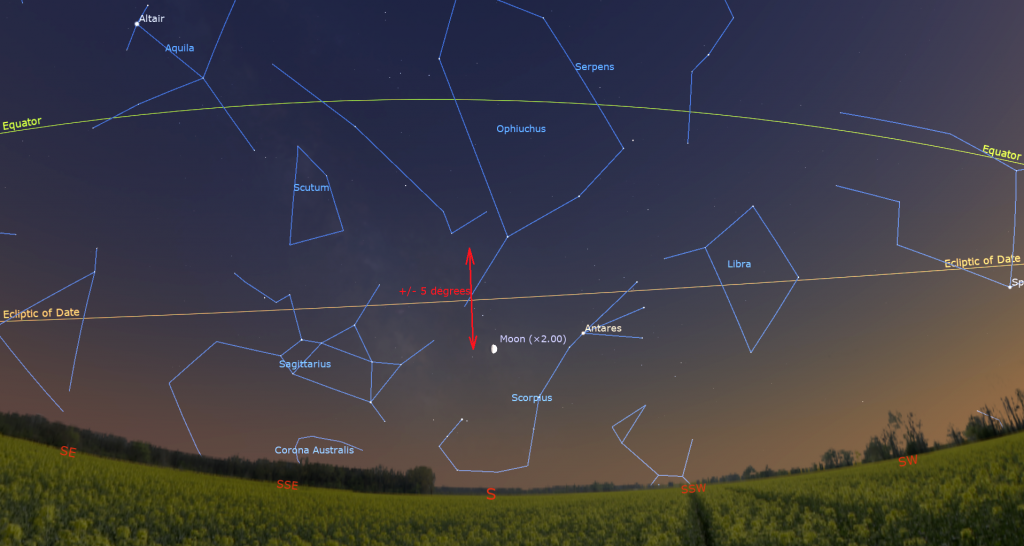
At this part of the lunar month, the moon is waxing towards full and shining in the sky from mid-afternoon to late night. The pole-to-pole boundary between the lit and dark hemispheres on the moon is called the terminator. Along that zone the sun is rising, so the lunar terrain on the sunny side of it is being lit by nearly horizontal rays of sunlight. Every little bump, hill, crater rim, ridge, and mountain peak will cast shadows to the west – producing breathtaking vistas through binoculars or a backyard telescope.
With no atmosphere to scatter the light, the shadows are inky black. Watch for crater floors that are fully dark or partially lit. Tall peaks on the dark side of the terminator will catch the sun first. The shape of the shadow on the crater floor tells us the depth profile of the crater – bowl-shaped or pie-pan. The length of the shadows tells us how tall the peaks are! Since the terminator is in constant motion, the view changes hour-by-hour and night-by-night. So find a spot where you can see the moon, and enjoy its sights with binoculars or a backyard telescope. Check back regularly to see things change.
The moon already started to grace the evening sky last week, so the earlier part of this week will provide the best views. As the moon approaches its full phase next Monday, it will look less “3D” under magnification because the sunlight will be arriving at a steep angle and throwing fewer shadows.
Today (Sunday) the waxing, 44%-illuminated crescent moon will rise after lunchtime and cross the southern sky. As the sky darkens after dusk, the bright moon will catch your eye low in the southwest.
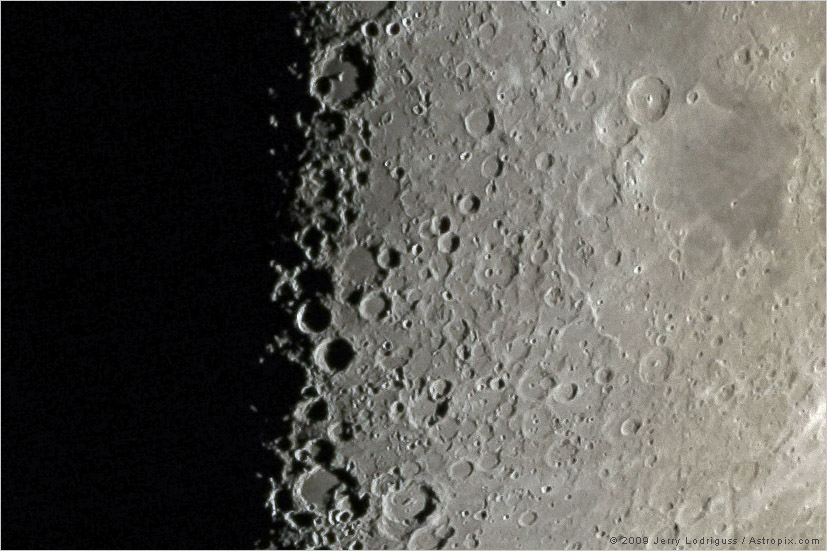
Several times a year, for a few hours near its first quarter phase, a feature on the moon called the Lunar X becomes visible in powerful, tripod-mounted binoculars and through any backyard telescope. When the rims of the craters Purbach, la Caille, and Blanchinus are illuminated from a particular angle by the sun, they form a small, but very obvious X-shape. The phenomenon is an example of pareidolia – the tendency of the human mind to see familiar objects when looking at random patterns. The Lunar X is located near the terminator, about one third of the way up from the southern pole of the moon (at lunar coordinates 2° East, 24° South). A prominent round crater named Werner sits to its lower right (or lunar southeast).
The X will begin to develop by about 8 pm EDT (or 00:00 GMT) tonight (Sunday, August 11). At that time the moon will be shining in a twilit sky in easterly time zones in the Americas and in a bright sky in western time zones. The pattern will peak in intensity about 90 minutes later and then disappear by about 11 pm EDT or 8 pm PDT. Viewing the moon through polarized glasses in a bright sky will increase the image contrast.
During a Lunar X event, you can also look for the Lunar V and the Lunar L. The “V” is produced by combining the small crater named Ukert with some ridges to the east and west of it. It is located a short distance above the moon’s equator at lunar coordinates 1.5° East, 8° North. There is a very interesting-looking area on the moon just to the right (or lunar east) of the “V”. Under magnification, the little crater Hyginus is crossed by a bent rille (or trough). North of that is a large, horseshoe-shaped “scar” that geologists suspect was a volcanic caldera. (Your telescope may flip and/or invert the view.)
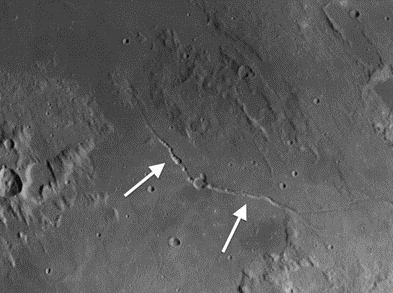
For a further challenge, see if you can see the letter “L” down near the moon’s southern pole. Its position is to the southwest of three prominent and adjoining craters named Licetus, Cuvier, and Heraclitus, which resemble Mickey Mouse’s head and ears. Some people claim they can see a letter-E on the moon during the Lunar X period, too. Then, by picking a round crater along the terminator to serve as the “O”, you can spell L-O-V-E! The patterns will be visible anywhere on Earth where the moon is shining, especially in a dark sky, between about 00:00 and 03:00 Greenwich Mean Time on August 12.

The moon will complete the first quarter of its journey around Earth on Monday morning at 11:19 am EDT, 8:19 am PDT, or 15:19 Greenwich Mean Time. At that time, its 90-degree angle away from the sun will cause us to see the moon half-illuminated – on its eastern side. The terminator will temporarily become straight. That told ancient astronomers that the moon was a sphere! Monday night’s moon will shine between the stars of Libra (the Scales) and Scorpius. The brighter stars of Libra used to be the tips of the scorpion’s claws.
On Tuesday the waxing, gibbous moon will rise in late-afternoon. As the sky darkens, Antares, the bright, reddish, supergiant star in the heart of Scorpius, will appear to just to the moon’s upper left, close enough for the duo to share the view in binoculars. Due to the moon’s continuous eastward orbital motion across the stars, it will pass closely below Antares for those viewing in westerly time zones. Observers in the South Pacific Ocean region, including the Galapagos Islands, can watch the moon pass in front of (or occult) Antares after midnight. Because Antares is located 4.5° south of the ecliptic, the moon frequently poses near and occults it.
As the moon increases its angle from the sun, it will wax in phase, rise about an hour later every night, and linger longer into the wee hours. On Wednesday night it will shine at the toes of Ophiuchus (the Serpent-Bearer), between Scorpius and the Teapot-shaped stars of Sagittarius (the Archer) – wiping out our view of the Milky Way beyond it. On Thursday the moon will pass close to one of those “teapot” stars, though you may need binoculars to see it beside the moon’s glare. The moon will gleam to the teapot’s left on Friday, and then spend the coming weekend as a nearly full, blinding spotlight in Capricornus (the Sea-Goat). That moon will be rising just before sunset and shining nearly all night long.
The Planets
Venus is continuing to increase its angle from the sun. That will make the brilliant planet easier to see just above the western horizon after sunset with each passing day. The severely tipped-over evening ecliptic (and Venus’ orbit running parallel to it) will keep Venus in the trees for the next few weeks – but as we approach next month’s September equinox, she will start to climb higher. Venus will be our brilliant “Evening Star”, gleaming high in the western sky throughout fall and winter.
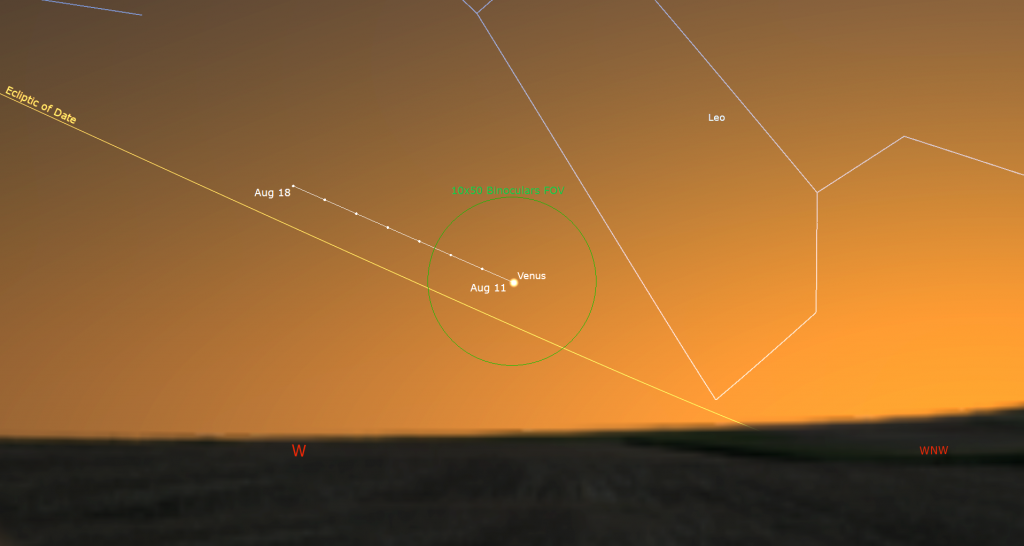
Observers in the tropics are already seeing Venus after sunset. At mid-northern latitudes, if your western horizon is unobstructed and free of cloud or haze, you can start to look for Venus’ very bright dot starting around 8:40 pm local time. The planet will be less than a palm’s width above the horizon. It’ll be the only bright star-like object. If you see something bright moving left or right, it’s an aircraft. Wait until the sun has fully set before using binoculars.
Have you seen Saturn yet? It will be the prominent, yellowish dot shining alone in the lower part of the southeastern sky in late evening every night. The ringed planet will be rising by 9:30 pm local time this week. That will advance by 30 minutes with each passing week. Saturn will spend the next 10 months among the rather lacklustre stars of eastern Aquarius (the Water-Bearer). Binoculars will show you a bent-line trio of stars named Psi Aquarii sparkling to Saturn’s lower right. The lower two are white, while the higher one is golden. Two redder stars named Phi and Chi Aquarii will appear to Saturn’s upper and lower right, respectively.
Saturn’s rings, which will effectively disappear when they become edge-on to Earth next March, already look like a thick line drawn through the planet’s globe. Good binoculars can hint that Saturn has rings, and any size of telescope will show them to you – and Saturn’s moons! Saturn’s largest and brightest moon Titan never wanders more than five times the width of Saturn’s rings from the planet. The much fainter moon named Iapetus can stray up to twelve times the ring width during its 80-day orbit of Saturn. The next brightest moons Rhea, Dione, Tethys, Enceladus, and Mimas all stay within one ring-width of Saturn.

During this week, Titan will migrate counter-clockwise around Saturn, moving from Saturn’s lower left (celestial east) tonight to the opposite side of the planet (celestial west) next Sunday night. (Remember that your telescope will probably flip the view around.) The rest of the moons will be tiny specks in a line beyond the rings. You may be surprised at how many you can see through your telescope if you look closely.
Earth’s perspective of the Saturn system this year and next year will cause its moons to align in the plane of the rings and produce frequent transits of Saturn’s moons and their black shadows across its disk – but you’ll need a high quality telescope to watch those. Tethys and its shadow will cross Saturn near the ring plane on Tuesday from 2:55 to 5:45 am EDT, Thursday from 12:15 to 3:05 am EDT, and Friday from 9:40 pm to 12:25 am EDT. The shadows of Dione and Rhea will cross several times, too.
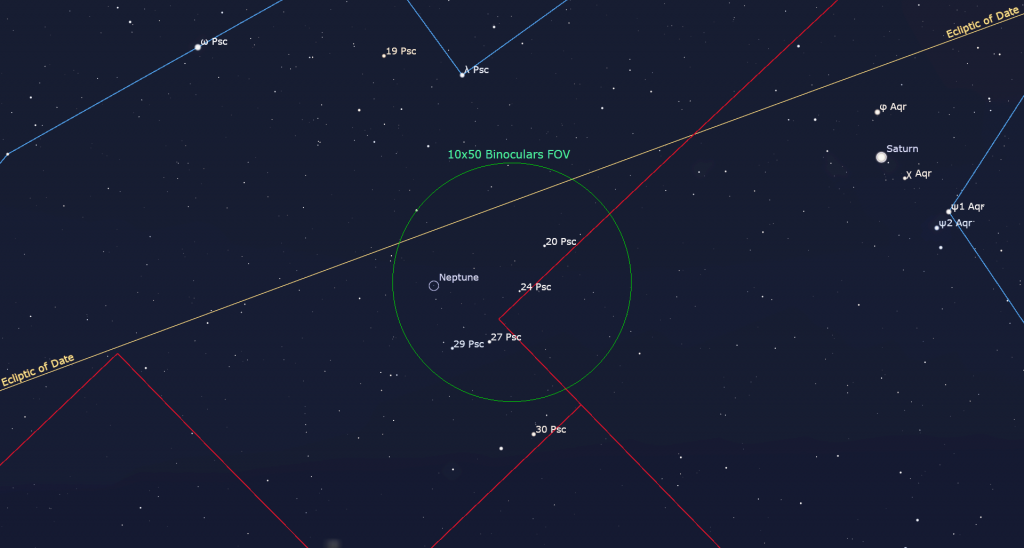
Neptune will rise 20 minutes after Saturn and follow it across the sky every night. The remote, blue planet will be spending this year in western Pisces (the Fishes), a generous fist’s width to the lower left (or 11° to the celestial ENE) of Saturn. Neptune doesn’t move very quickly through the stars. It will be located a bit more than a thumb’s width to the upper left (or 2° north) of a medium-bright star named 27 Piscium, allowing them to share the view in binoculars. Other less-brilliant stars nearby named 29 Piscium, 24 Piscium, and 20 Piscium will help guide you to Neptune with a backyard telescope or good, strong binoculars. For now, you’ll need to look at Neptune while it’s higher up and the sky is dark – between about midnight and 5 am local time.
Uranus will start to rise before midnight this week – but it won’t climb high enough for viewing until about 2 am local time. It’ll rise about 30 minutes earlier every week, but you could always head outside with binoculars or a backyard telescope before 4:30 am if you are keen to see it now. Personally, I’ll wait a month! In binoculars and a backyard telescope Uranus will appear as a dull, non-twinkling, blue-green star positioned about a palm’s width to the lower right of the bright Pleiades star cluster.

Jupiter and Mars are the main attraction in the morning sky nowadays. They’ll both rise at about 1:30 am local time and remain visible in the eastern sky until almost sunrise. Jupiter will be an absolutely stunning, brilliant white “star”. Reddish, less-bright Mars will shine close to it. If you head out to view those planets while it’s still dark, you’ll see that they are perched between the horns of Taurus (the Bull), with the winter constellations of Orion (the Hunter) and Gemini (the Twins) arranged below them.
Mars’ eastward orbital motion has been carrying it towards Jupiter for some time. The red planet will finally pass extremely close to Jupiter on Wednesday morning, and then slide farther to the bright planet’s lower left (celestial east) after that. The two planets will still be cozy enough to view together in the eyepiece of a small telescope until next Sunday. In a telescope, Mars will display a small, rusty-coloured disk. Its position on the far side of the sun from Earth is keeping the planet looking small until later this year. If you do check it out, take notice that Mars is only 88%-illuminated because its angle from the sun is 63°.
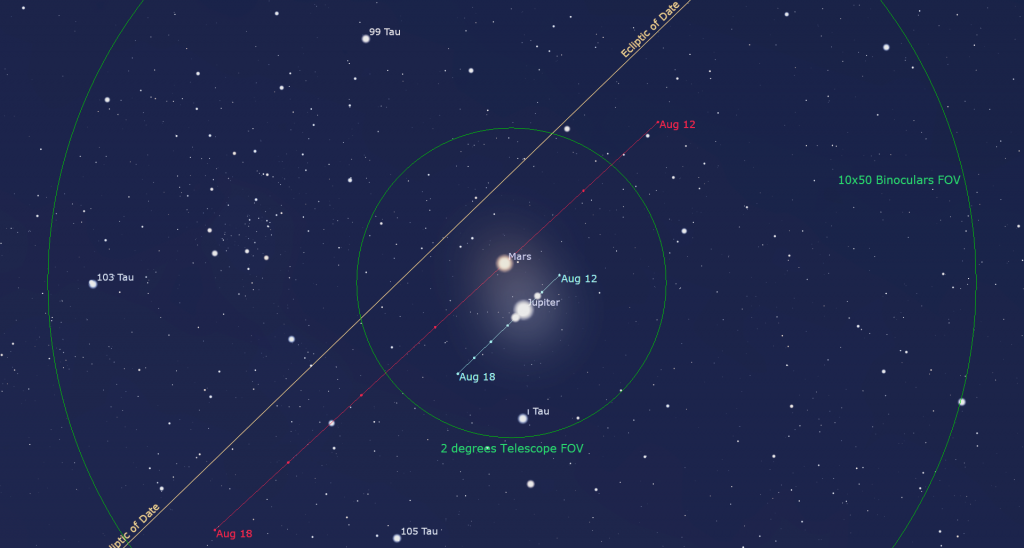
Binoculars will show Jupiter’s four Galilean moons named Io, Europa, Ganymede, and Callisto lined up beside the planet. Those moons complete orbits of the planet every 1.7, 3.6, 7.2, and 16.7 days, respectively. If you see fewer than four moons, then one or more of them is crossing in front of or behind Jupiter, or hiding in Jupiter’s dark shadow – or two of the moons are very close together or occulting one another. Even a small, but decent quality telescope can show you Jupiter’s dark belts and light zones, which are aligned parallel to its equator. With a better grade of optics, Jupiter’s Great Red Spot, a cyclonic storm that has raged for hundreds of years, becomes visible for several hours when it crosses the planet every 2nd or 3rd night. For observers in the Americas, that GRS will cross Jupiter’s disk on Tuesday, Friday, and next Sunday morning. If you have any coloured filters or nebula filters for your telescope, try enhancing the spot with them.
From time to time, observers with good quality telescopes can watch the black shadows of the Galilean moons travel across Jupiter’s disk. On Wednesday morning, August 14, for observers in most of the Americas, two shadows will cross the southern hemisphere of Jupiter simultaneously. At 5:35 am EDT (or 09:35 GMT), Europa’s shadow will join the slightly larger shadow of Io that began its own crossing at 4:45 am EDT (08:45 GMT). As the shadows are crossing the planet, Io and Europa themselves will approach and then move onto the planet. Io’s shadow will complete its passage at 6:50 am EDT (10:50 GMT), leaving Europa’s shadow to journey on alone until 8 am (or 12:00 GMT). The sky will be bright by them in the easterly time zones. On Friday morning, August 16, Ganymede’s large shadow will cross Jupiter’s southern polar region from 2:51 to 4:40 am EDT (or 06:51 to 08:40 GMT).
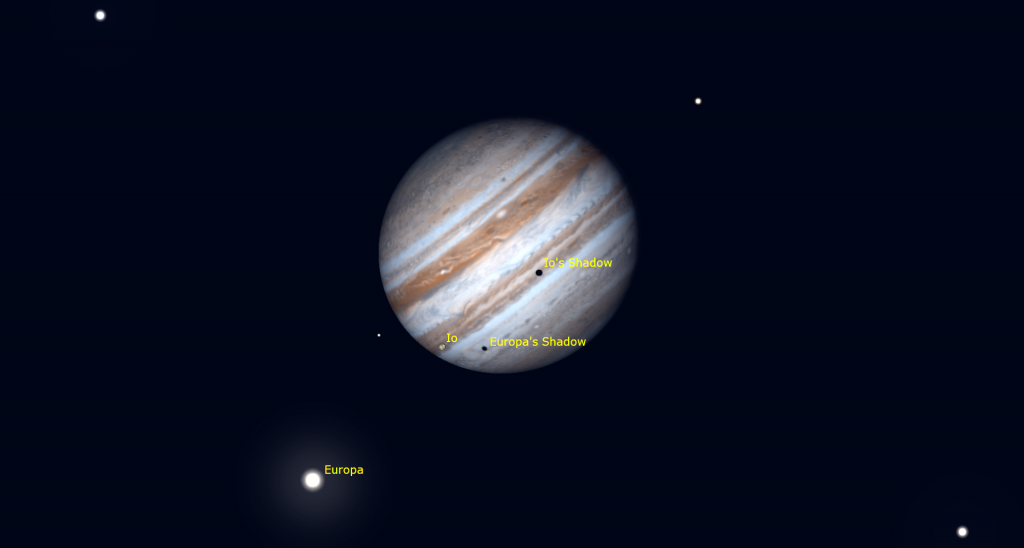
Public Astronomy-Themed Events
Every Monday evening, York University’s Allan I. Carswell Observatory runs an online star party – broadcasting views from four telescopes/cameras, answering viewer questions, and taking requests! Details are here. They host in-person viewing on the first clear Wednesday night each month. Other Wednesdays they stream views online via the observatory YouTube channel. Details are here.
On the first clear weeknight this week (August 12-16) the public are invited to Binoculars Stargazing on the lawn at the David Dunlap Observatory. Arrive for this free program at sunset. You’ll learn to use star charts and basic observing techniques, and then use your binoculars to follow a guided tour through the night sky by RASC Toronto Centre astronomers, and stay after the tour to practice your new skills. Please wear / bring appropriate supplies for being outside. Note that there is no building or washroom access during this program. All participants under the age of 16 must be accompanied by an adult. As this program is weather dependent, please visit RASC Toronto’s home page or Facebook page for a GO or NO-GO call.
Space Station Flyovers
The ISS (or International Space Station) will not be visible over the Greater Toronto Area this week.
Keep your eyes on the skies! I love getting questions and requests. Send me some!